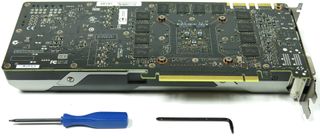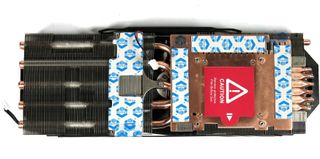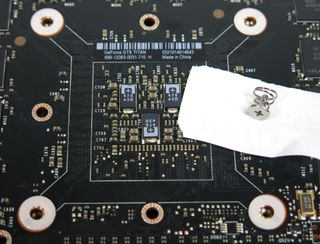Gigabyte GeForce GTX Titan Black: Do-It-Yourself Cooler Swap
Nvidia doesn’t allow its partners to sell the GeForce GTX Titan Black with proprietary cooling. However, Gigabyte now offers a GHz Edition of the card that comes bundled with its WindForce solution, which you can install on the overclocked board yourself.
Upgrading The Gigabyte GeForce GTX Titan Black
A Step-by-Step Guide to Upgrading the GeForce GTX Titan Black
We’re ripping apart a thousand-dollar GeForce GTX Titan today. Obviously, the operation requires deliberate movements and a heaping dose of caution. Tearing off the reference cooler and bolting down Gigabyte's is not the way to approach this.

First, the reference cooler needs to be unscrewed. Gigabyte does include a universal tool for this, but using your own screwdriver is both faster and easier. Fortunately, the bundled manual is comprehensive enough to walk you through the process without any confusion that'd lead to mistakes.

If only because the original reference cooler should be saved, I collected all of its tiny screws into a small bowl. From there, it's easy to lift the heat sink up and off. Don't rush; you need to unplug a connector up top and another down below before the heat sink clears the card.

From there, Nvidia's cooler can be removed, greeting you with a bunch of gunk. The company doesn't shy away from blanketing its GK110 GPU with thick, heavy, and hard-to-remove thermal paste.

Gigabyte must anticipate this for each of its GeForce GTX Titan Blacks, so it provides a cloth for cleaning up the compound. That's a solid idea, though we'd also recommend using the right cleaning solutions.

As mentioned, the reference cooler (which is actually quite valuable) and screws are stowed away just in case warranty-related issues necessitate sending the card back. You're better off safe than sorry.

I chose to set aside the thick thermal paste Gigabyte bundles with its GeForce GTX Titan Black GHz Edition. There are higher-end solutions out there, after all. You want a non-electrically conductive compound that doesn’t need a lot of burn-in, is easy to apply and spread, and performs well. After quite a bit of comparison testing, I standardized on Gelid’s GC-Extreme for my graphics card reviews, so I lean on that compound to normalize one more variable as I compare Gigabyte's card to other modified graphics cards in the lab.
Stay on the Cutting Edge
Join the experts who read Tom's Hardware for the inside track on enthusiast PC tech news — and have for over 25 years. We'll send breaking news and in-depth reviews of CPUs, GPUs, AI, maker hardware and more straight to your inbox.

It’s time to install the new cooler. Remove the protective covers from the thermal pads, and pull off the big warning label. I took the extra step of cleaning the copper surface with Arctic’s purifier solution to make sure any remaining remnants of glue were gone.

First, the four washers are glued to their respective holes. Then, plug the fan connector into its socket on the bottom, and rest the cooler on the graphics card. The WindForce logo LED connector is attached next. Fasten the heat sink using spring-loaded screws tightened in a cross pattern.

Next, three small screws are secured into place around the voltage transformers. Finally, you'll find yourself with just one screw left. It requires a nut, which is also included. With it in place, the cooler installation is complete.

It’s a little disappointing that Gigabyte doesn't include a backplate. The cooler is fastened securely and solidly in seven places, and the card seems safe from flex, but additional cooling under the voltage transformers and rear-mounted memory modules would have been nice as well.
Current page: Upgrading The Gigabyte GeForce GTX Titan Black
Prev Page The Gigabyte WindForce 600 Graphics Card Cooler Next Page Dimensions And Pictures: The Upgraded Gigabyte GeForce GTX Titan Black-
ShadyHamster Reply13466306 said:So we have to change the cooler by our self? now thats wierd.
If you bothered reading the first page you'd know why. -
bloodgigas Reply13466306 said:So we have to change the cooler by our self? now thats wierd.
If you bothered reading the first page you'd know why.
"Nvidia doesn’t allow its partners to sell the GeForce GTX Titan Black with proprietary cooling. However, Gigabyte now offers a GHz Edition of the card that comes bundled with its WindForce solution, which you can install on the overclocked board yourself."
This one right? whats the difference between you install it yourself and Gigabyte take the initiative pre-factory installed? or Warranty Void? -
bloodgigas Reply13466306 said:So we have to change the cooler by our self? now thats wierd.
If you bothered reading the first page you'd know why.
"Nvidia doesn’t allow its partners to sell the GeForce GTX Titan Black with proprietary cooling. However, Gigabyte now offers a GHz Edition of the card that comes bundled with its WindForce solution, which you can install on the overclocked board yourself."
This one right? whats the difference between you install it yourself and Gigabyte take the initiative pre-factory installed? or Warranty Void? -
FormatC It is one of Nvidias funny rules.Reply
Ok, for your better understanding:
Nvidia doesn’t allow its partners to sell the GeForce GTX Titan Black with factory-installed proprietary cooling. -
envy14tpe If you are dropping the cash on a Titan I really wish people would go liquid cooling. Seems to be the best.Reply -
chaosmassive Nvidia doesnt permit to install any 3rd party cooling on their chip, now thats weird !Reply -
wolverine96 Very nice, Gigabyte! I almost wish I had bought one. I have one of those "out of stock ASUS cards from Newegg". I am not disappointed, though. The card handles 84 degrees Celsius just fine!Reply
Igor Wallossek, I wonder if you could put up a graph for 3D rendering? If you use Blender's BMW scene by Mike Pan (a popular benchmark scene), make sure you properly set the tile size! -
Damn_Rookie Reply
Silly question probably, but why does nVidia allow only EVGA to break this rule, with their hydro copper signature edition you mentioned? Is it just because it's a water cooled model? Do you think nVidia specially signs off on the design?13466699 said:It is one of Nvidias funny rules.
Ok, for your better understanding:
Nvidia doesn’t allow its partners to sell the GeForce GTX Titan Black with factory-installed proprietary cooling.
I'm genuinely curious.
Most Popular

